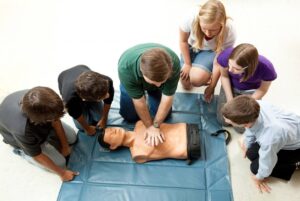
by admin | May 28, 2025 | Business
Oil water separators are essential for petrol stations, construction sites, marine operations, car wash businesses and any other business or location prone to oil contamination.
These systems prevent harmful discharge into stormwater by separating oil, grease, and hydrocarbons from wastewater. Ensuring compliance with environmental legislation throughout Australia, they also play a role in water recycling for businesses looking to reduce mains water usage and any wastewater disposal costs.
From workshops to wash bays, oil water separators are adaptable to a variety of environments and contamination levels. The following breakdown explains how these systems function, the key benefits for your business, and why professional guidance is essential.
How Do Oil Water Separators Work?
Oil separators operate by using gravity and separation technology to remove oil and hydrocarbons from water. The process typically involves the following steps:
- Initial Separation – Wash water enters the oil separator, where heavier solids such as dirt and debris, settle at the bottom.
- Oil Separation – Lighter oils and hydrocarbons float to the surface, while water flows through internal baffles that enhance separation.
- Coalescing Plate Technology (Advanced Systems) – Specialised coalescing plates help small oil droplets merge into larger droplets, making them easier to separate and remove.
- Clean Water Discharge – The treated water is either discharged in compliance with regulations or directed to a recycling system for reuse.
Oil Water Separators Vs. Oil Skimmers
While oil skimmers are often used for removing surface oils from water, they are generally less effective than oil separators in commercial applications. Skimmers work by using belts, disks, or brushes to remove floating oil, but they struggle with emulsified oils and small oil droplets that remain suspended in water.
Key advantages of oil separators over oil skimmers:
- More Comprehensive Treatment: Oil separators can handle free-floating and emulsified oils, whereas skimmers only remove surface oil.
- Better Compliance: Skimmers may not meet stringent wastewater discharge regulations, while separators ensure full compliance.
- Higher Efficiency: Coalescing plate separators significantly improve oil separation, making them more effective for high-volume wash bays.
- Reduced Maintenance: Skimmers require frequent cleaning and adjustment, whereas oil separators operate with minimal maintenance.
Due to their ability to handle both free-floating and emulsified oils, oil water separators are the gold standard in commercial wastewater treatment. As such, if you’re a business or commercial entity seeking a long-term, high-performance solution for wastewater management, this is the option most experts recommend.

(Image: Oil skimmers cannot remove suspended oil. Credit: z1b/Getty Images)
Why Oil Water Separators Are Essential in Commercial Wastewater Management
As noted above, the presence of oil and hydrocarbons in wastewater can lead to severe environmental and operational challenges. Oil water separators are specifically designed to address these risks by providing effective removal of contaminants, ensuring cleaner water discharge and promoting sustainable water reuse practices.
Investing in a quality oil water separator as part of a commercial water treatment system offers several benefits, including:
- Environmental Protection: Prevents oil pollution and protects local water bodies.
- Regulatory Compliance: Meets industry and government wastewater discharge standards.
- Improved Water Recycling: Enhances the efficiency of water treatment and recycling systems.
- Reduced Maintenance Costs: Prevents blockages and damage to wastewater infrastructure.

(Image: Efficient wastewater management. Credit: Armastas/Getty Images)
The Importance Of Investing In Superior Oil Water Separator Solutions
Wherever there are large volumes of water at a high flow rate that contain oil, grease or similar contaminants, measures must be in place to stop these being washed into waterways and remain legally compliant. This is why installation of an oil water separator is an essential requirement for commercial wastewater treatment, whether in wash bays, workshops or industrial sites.
Rather than navigating this independently, ensuring your business invests in a quality oil water separator, tailored to your business needs and installed by an expert is strongly recommended.
Not only will this provide peace of mind that your operations can continue to run smoothly, this also ensures that you are operating sustainably, responsibly and that legal repercussions from non-compliance can be avoided.

by admin | Mar 18, 2025 | Guest Post
Key Highlights
- Enhance your IT service management skills with ITIL 4.
- Explore the service value system and its impact on business value.
- Master practical skills like the seven guiding principles and continual improvement.
- Adapt to digital transformation with ITIL 4’s guidance.
- Propel your career forward with ITIL 4 certifications and high-performance teamwork.
Introduction
In our tech-driven world, IT professionals must keep up to succeed. This is why an ITIL 4 Foundation certification, specifically the ITIL 4 Foundation certification exam, is important for enhancing IT service quality. ITIL 4 gives a complete guide for service management. It focuses on continual improvement and adds value for customers.
Key Skills and Trends from ITIL 4 Course to Elevate Your IT Career

An ITIL 4 course gives you key skills to manage the changing world of IT. You will learn about the ITIL 4 framework and practical methods for service management. This knowledge is useful in many industries and job roles.
Since businesses depend more on technology, ITIL 4 is important to connect IT with business goals.
Understanding ITIL 4 Framework and Its Importance in the Modern IT Landscape
The ITIL 4 framework takes a broad view of service management. It goes beyond just traditional IT processes. It focuses on how to create value, improve customer experience, and reach business goals using technology.
Today, its importance in information technology (IT) is clear. Many organizations need to keep up with fast technology changes and new customer needs. ITIL 4 helps these businesses handle these challenges. It gives them a common language and the best practices for information technology service management. With the ITIL framework, companies can build effective, customer-centered IT services that align with their business aims.
The Role of Service Value System (SVS) in Delivering Business Value
The Service Value System (SVS) plays a key role in providing business value in IT service management and ensuring warranty for services. It covers the whole service value chain and puts a strong focus on continual improvement and service delivery. With parts of service management like service level management, service request management, and IT asset management, the SVS helps maintain service quality. ITIL 4 courses give IT professionals the skills to improve the value streams from service providers and boost the value of IT services. It’s important for help desk managers, IT project managers, and IT managers to understand the SVS so they can use best practices well.
Core Components of ITIL 4 and How They Enhance IT Service Management

ITIL 4 brings key parts that improve IT service management. It gives helpful and clear advice for businesses. These parts help organizations be more agile and flexible. They can adjust quickly to changing business needs.
By using these parts, organizations can make their IT operations smoother. They can also raise service quality. In the end, this means providing more value to customers.
Exploring the Four Dimensions of Service Management for a Holistic Approach
ITIL 4 highlights a complete approach to service management. It recognizes the Four Dimensions of Service Management. This idea reminds us that good IT service management must look at and balance all these dimensions:
- Organizations and People: This dimension shows how important it is to have the right structure, culture, and skilled people to provide and support IT services.
- Information and Technology: This dimension includes the information and technology needed to offer IT services. This involves hardware, software, data, and the necessary infrastructure.
- Partners and Suppliers: This dimension knows that organizations do not work alone. It focuses on creating and managing relationships with partners and suppliers to ensure smooth service delivery.
- Value Streams and Processes: This dimension points out the need to define clear value streams that meet customer needs and improve processes to deliver value effectively.
The Service Value Chain: Integrating Activities for Optimal Service Delivery
The Service Value Chain is an important part of ITIL 4. It shows how all activities that create value should work together. This helps us understand how different tasks help provide a valuable service to the customer.
There are six main activities:
- Plan: Setting business goals, strategies, and plans for service delivery.
- Improve: Finding ways to make services better and putting improvement plans into action.
- Engage: Working with stakeholders to understand their needs and what they expect.
- Design & Transition: Creating new or updated services and moving them to the live setting.
- Obtain & Build: Getting and developing the needed resources and skills to provide services.
- Deliver & Support: Making sure services are given and supported well to fulfill customer needs.
By bringing these activities together, companies can make sure that value creation flows smoothly, improve service delivery, and increase customer satisfaction.
Practical Skills You’ll Acquire from an ITIL 4 Course
An ITIL 4 foundation course is not just about theory. It gives you useful skills that you can use in real life, especially for business process analysts. You will learn how to apply ITIL’s best practices in your organization. This applies to service strategy, design, transition, operation, and improving services over time.
These practical skills will help you solve problems better. This makes you a more important part of IT teams.
Applying the Seven Guiding Principles in Everyday IT Scenarios
The seven guiding principles are essential for the ITIL 4 framework. They help with decision-making and ensure that service management is successful. These principles keep IT services in line with business goals, satisfy user needs, and create the best value.
It is important to understand and use these principles in daily IT situations to achieve success in IT service management, especially in terms of information security management:
- Focus on Value
- Start Where You Are
- Progress Iteratively with Feedback
- Collaborate and Promote Visibility
- Think and Work Holistically
- Keep It Simple and Practical
- Optimize and Automate
By making these principles part of the company culture and decision-making, businesses can build a customer-focused approach to IT service management.
Mastering Continual Improvement for Sustained IT Service Excellence
Continual improvement is the main part of the ITIL 4 framework. It helps IT services grow and change to meet new needs. This ongoing process is very important for making IT work better, improving service quality, and helping with new ideas.
IT professionals must understand and use the continual improvement model. This model is key for handling changes and facing new challenges. Here are the steps to follow:
- What is the vision or desired state?
- Where are we now?
- How do we get there?
- Take action!
- Did we achieve the objective?
By using this way of thinking, organizations can build a culture of continuous learning, change, and creativity in IT service management.
Adapting to the Digital Transformation with ITIL 4

The IT industry is always changing. Businesses need to adjust to new technologies and methods to stay competitive. ITIL 4 understands this need for flexibility. It supports adding new technologies and methods to the current structure.
When organizations adopt digital transformation within the ITIL 4 framework, they can use technology in a smart and efficient way.
Leveraging Digital and IT Strategy to Drive Business Success
In today’s business world, having a strong digital and IT plan is very important. ITIL 4 highlights the need to match digital changes with the overall business goals. This way, technology spending creates real value and helps the organization succeed.
When these strategies match, IT teams can better support business goals. They can improve operations and provide better customer experiences.
To make sure digital and IT plans align well, companies should focus on:
- Clear Communication and Collaboration: Encourage honest communication and teamwork between IT and business teams.
- Value-Driven Approach: Focus on important technology investments.
- Adaptability and Flexibility: Be ready to change and adjust plans as technology and business needs shift.
Adopting New Technologies and Practices within the ITIL 4 Framework
ITIL 4 is important today because it keeps up with fast changes in technology. It helps organizations use new tools and methods without causing problems with their current systems.
The main focus is to use these technologies smoothly:
- Cloud Computing helps businesses grow, become more flexible, and save money. ITIL 4 is useful for managing cloud services well.
- AI can take over tasks, help in making better choices, and improve user experiences. The ITIL framework supports how to set up and manage AI-based solutions.
- DevOps encourages teamwork and allows faster software creation and launch. ITIL 4 ideas can fit well with DevOps practices.
This flexibility makes ITIL 4 a great choice for IT service management. It helps organizations keep up with new technology.
ITIL 4’s Role in Career Advancement and Professional Development
Getting ITIL 4 certifications shows that you care about your professional growth. It boosts your credibility and makes you more employable in the IT field. ITIL 4 is known worldwide. It gives IT teams a common language and a shared understanding.
This certification can lead to new job opportunities, promotions, and the chance to earn more money.
How ITIL 4 Certifications Propel Your IT Career Forward
In the competitive IT job market, getting certifications is important. They show your skills and commitment. ITIL 4 certifications are especially useful. They tell potential employers that you understand the best practices in IT service management.
Here are some benefits of earning ITIL 4 certifications for IT professionals:
- Increased Earning Potential: Certified professionals usually earn more money because they have specialized knowledge and skills.
- Enhanced Job Opportunities: Companies want people with ITIL qualifications. Certifications help you get noticed and can lead to new and diverse job options.
- Improved Career Progression: People who focus on professional development are valued. This makes them strong candidates for promotions and leadership positions.
The Significance of ITIL 4 in Achieving High-Performance IT Teams
ITIL 4 plays a pivotal role in developing high-performance IT teams by establishing a common framework for service management and promoting a shared understanding of best practices. This shared framework fosters collaboration, streamlines communication, and reduces misunderstandings within the team.
| Feature |
Benefit |
| Common Language and Framework |
Enables clear communication |
| Shared Understanding of Best Practices |
Promotes efficiency and consistency |
| Focus on Value and Customer Satisfaction |
Aligns team goals and priorities |
| Continual Improvement Mindset |
Encourages innovation and problem-solving |
| Defined Roles and Responsibilities |
Improves accountability and teamwork |
By embracing ITIL 4, organizations can cultivate a culture of excellence, driving higher team performance and better service delivery.
Conclusion
In conclusion, taking an ITIL 4 course can boost your IT career by demonstrating the value of ITIL. It teaches you important skills and knowledge that fit with today’s IT practices. You will learn about the ITIL 4 framework. You will also master the Service Value System and apply the Seven Guiding Principles. These lessons improve IT service management. By embracing digital transformation with ITIL 4, you can help drive business success. You will also learn to adapt to new technologies easily. With ITIL 4 certifications, you can move up in your career and build strong IT teams. Grow your career and find new chances in the fast-changing IT world by signing up for an ITIL 4 course today.
Frequently Asked Questions
What is the best way to prepare for the ITIL 4 certification?
Carefully go over the ITIL Foundation exam syllabus. Use official study materials and practice tests to prepare. Think about joining a recognized training course led by instructors with years of practical experience to boost your knowledge and exam readiness. Having an exam voucher code will also be helpful.
How does ITIL 4 adapt to the evolving IT landscape?
ITIL 4 offers a flexible framework that allows for the addition of new technologies and methods, aligning with established ITSM practices. It focuses on the ongoing improvement of service management practices. This helps keep it useful as businesses change and adapt to digital transformation and new demands.

by admin | Mar 18, 2025 | Education
Key Highlights
- Flexible scheduling options to accommodate busy lives, giving peace of mind.
- Access to expert tutors across Australia, ensuring quality instruction.
- Flexible scheduling options to accommodate busy lives, giving peace of mind.
- Interactive tools and resources to enhance the learning experience.
- Comprehensive support for a wide range of subjects, from math and science to language arts and test preparation.
Introduction

Benefits of Subject-Specific Online Tutoring
Subject-specific online tutoring has many advantages over traditional tutoring. Students can find highly qualified tutors who specialize in the subjects they need help with. This means students get focused and effective instruction.
Also, online tutoring is very flexible. Students can set up sessions when it works best for them, catering to each child’s needs. This means no travel and fits well with busy lives. The personal touch, along with interactive tools and the highest quality digital resources, makes learning fun and helps meet different learning styles. Importantly, the most important thing is ensuring that each child feels supported in their unique learning journey.
Personalised Learning Paths for Every Student
One of the best things about subject-specific online tutoring is that it can create personal learning plans. The right tutor, especially a qualified teacher, will take the time to learn about a child’s needs, strengths, and weaknesses, providing different ways to address these aspects. This individual approach helps make sure that tutoring sessions focus on the areas where a student needs the most help.
By paying attention to how each person learns and their speed, online tutors can make a supportive and positive learning space without the presence of classmates. This close attention helps students feel more confident and grow in their understanding of the subject.
When students feel supported and understood, they are more likely to connect with the material and reach their academic goals through a holistic approach. For example, an ITIL 4 course could be customized to suit a learner’s pace and focus on areas like IT service management, ensuring better engagement and comprehension. Subject-specific online tutoring gives the personal attention needed to encourage a love of learning and success in school.
Access to Expert Tutors Across Australia
Finding good tutors in Australia, including tutoring on the Gold Coast, in Canberra, and in Adelaide, is easy with online platforms like KIS Academics. They have many experienced educators. Students can connect with expert maths tutors and more. These tutors know their subjects well and love teaching, which helps ensure high-quality lessons.
With these online platforms, students can find high school tutoring from anywhere in Australia, including Sydney and Perth. This means they don’t have to worry about where they live. They can choose from a larger number of special tutors.
No matter if a student lives in a big city or a remote area, online tutoring means they can get the best educational help possible.
Flexible Scheduling to Accommodate Busy Lives
Online tutoring understands that students today have busy lives. They balance school, activities, and family. Flexible scheduling is a key part of online tutoring. It lets students learn at their own pace and pick times that fit easily into their lives.
Gone are the days of strict tutoring times and the hassle of going to appointments. Now, with online tutoring, students can log in from the comfort of home when it works best for them.
This flexibility helps students get the support they need without adding more stress to their busy schedules.
The Role of Interactive Tools and Resources in Online Learning

Online tutoring platforms are different from regular tutoring. They use interactive tools and resources to make learning more fun. Features like virtual whiteboards, screen sharing, and quizzes change how students learn.
These tools help tutors and students work together in real-time, making lessons more lively. Plus, having access to digital resources, like practice exercises and educational videos, gives students many chances to strengthen their understanding and build important skills, truly serving as a game changer in the learning process.
Leveraging Multimedia Content for Engaging Lessons
Modern online tutoring platforms use interactive tools and multimedia content to create fun lessons. They include videos, animations, and simulations. This helps tutors reach different learning styles and makes tough ideas easier to understand.
For example, visual learners may learn better by watching a video about a math idea. Auditory learners might understand the material more clearly through audio recordings. Using multimedia content changes the learning experience and makes it more exciting for students.
When students are engaged and interested, they can understand and remember their lessons much better.
Utilizing Virtual Labs for Science Experimentation
Science subjects often require students to do practical experiments. This can be tough in a regular online classroom. Virtual labs help with this problem. They give high school students a chance to do experiments and learn about science in a safe digital space.
These interactive simulations are like real labs. They let students change different factors, gather data, and look at the results. This helps them understand scientific ideas better. With a hands-on and curious learning experience, virtual labs change the way science is taught.
Students can discover scientific ideas in a fun and safe place. They develop important skills like critical thinking and problem-solving. These skills are vital for success in STEM fields.
Exploring Online Tutoring Resources for Math, Science, and Beyond

Online tutoring is great for STEM subjects, but it helps in many other areas too. If a student needs help with essay writing, learning a new language, or preparing for tests, many specialized online tutoring resources can help.
These resources offer focused teaching and support. They assist students of all ages and levels in reaching their learning goals. Online tutoring platforms see that learners have different needs. They provide complete solutions to tackle academic challenges in various subjects.
Comprehensive Guide to Mastering Mathematics
Mathematics can be tough for many students. However, online tutoring can help students master math skills, and after the first lesson, many students notice significant improvements. Online maths tutors offer learning that is just right for each student. They break down tricky ideas into easier steps.
With interactive tools and feedback just for them, students can build a strong base in math. They will also grow their problem-solving skills and feel more confident. For some students, it might even be the first time they feel engaged with math. Online resources give access to practice quizzes, worksheets, and video lessons. This helps students strengthen what they learn and check their progress.
This all-around approach helps students get past their fear of math. It helps them succeed in this important subject.
Navigating the World of Online Science Tutoring
Online science tutoring helps students explore the exciting world of science in a fun and engaging way. Skilled tutors assist students with tough scientific ideas, helping them understand the subject better.
Virtual labs and simulations give students practical learning experiences. These tools let students use what they know and build important thinking skills. If a student needs help with biology, chemistry, physics, or any other science topic, online tutoring gives them access to expert help and support.
Students can learn at their own pace. They can ask questions anytime and get personal feedback. This way, the learning process becomes more effective and enjoyable.
Enhancing Language Arts Skills Through Digital Platforms
Online tutoring is not just for STEM subjects. It also helps students improve their language arts skills. Digital platforms offer many resources and tools for primary school tutoring and beyond. They help students grow in reading, writing, and communication.
Online tutors can help with grammar, vocabulary, reading comprehension, and essay writing. They give personalized feedback and guidance. Interactive exercises, like online quizzes and writing prompts, help students practice their skills. This supports them in building confidence.
Whether a student needs help with creative writing, persuasive essays, or literary analysis, online tutoring resources are here to help. They can improve their language arts skills and develop a love for language.
Discovering Resources for Advanced Placement (AP) Subjects
Explore advanced placement (AP) subjects with online tutoring resources made just for you. Find lots of support to help you understand tough high school topics. If you need help in math, science, or other subjects, you can connect with quality tutors who fit your learning speed. You will get individual attention and a learning plan to improve your academic performance. Enjoy the convenience of online tutoring from the comfort of your home, with experienced teachers helping you succeed.
Tailored Tutoring for Standardized Test Preparation
Standardized tests, like the HSC exams, are very important in a student’s education. Online tutoring platforms understand how vital these exams are. They offer personalized tutoring programs. Skilled tutors help students with the knowledge and practice needed to do well on these important tests.
For example, HSC tutoring programs can focus on parts of the exam, such as English, math, or science. They give students specific help and practice materials. With custom support and solid test-taking strategies, online tutoring helps students feel confident as they take standardized tests. This way, they can reach the scores they want.
Conclusion
In conclusion, online tutoring that focuses on specific subjects gives students in Australia a custom learning experience. Students can connect with the perfect tutor and expert private tutors and choose a schedule that works for them, provided they have a stable internet connection. The interactive tools, including multimedia content and virtual labs, make learning fun and effective. Whether you want to improve in mathematics, explore science, or develop language skills, online resources meet many needs. Using these special resources can help students do well on tests and advance in their studies. Join the online tutoring world to improve your education. If you need reliable online tutoring in Australia, check out the options to reach your full academic potential.
Frequently Asked Questions
How do I find a reliable online tutor in Australia?
Finding a good online tutor in Australia begins on sites like KIS Academics, where you can explore options for private tutoring. Here, you can look through different profiles and book a free first session. This helps you find the right fit. Communication is important, and a focus on students will also give you a great experience.
How can parents or teachers track a student’s progress when using subject-specific online tutoring resources?
Many online platforms give regular progress reports via email. These reports show a student’s performance, areas to improve, and the achievement of learning goals. This keeps parents and teachers informed during the tutoring process.
How can online tutoring resources help students improve their understanding of complex subjects like math and science?
Online tutors provide individual attention by giving simple explanations and using fun tools. They help make tough subjects like math and science easier to understand. This way, students can grasp challenging material more easily.

by admin | Dec 4, 2024 | Health
Building trust and confidence with families is the cornerstone of effective therapy in the world of Applied Behavior Analysis (ABA). Families come to therapists not just seeking help but also hoping to feel heard, supported, and understood. By creating a family-centered therapy environment, therapists can foster a welcoming and supportive atmosphere where parents and caregivers feel empowered to participate in their child’s journey. This collaborative approach ensures that therapy is not only effective but also meaningful for the entire family.
What is a Family-Centered Therapy Environment?
A family-centered therapy environment prioritizes the active involvement of families in the therapy process. This approach acknowledges that parents and caregivers are experts in their child’s needs, preferences, and daily routines. By involving families as partners, therapy becomes more personalized, practical, and sustainable. It’s not just about teaching a child new skills; it’s about ensuring these skills can be applied at home, in school, and in the community.
Shakira Millar, a Care Coordinator and Lead Therapist, emphasizes that building trust with families starts with clear communication and a shared sense of purpose. “Families need to feel that they are part of the process,” she says, “not just observers but active participants who are valued and respected.”
The Importance of Trust in ABA Therapy
Trust is the foundation of any successful relationship, and it’s particularly crucial in therapy. Families are entrusting therapists with something deeply personal—the well-being and development of their child. Without trust, even the most well-intentioned strategies can fall short.
Trust is built through consistency, transparency, and empathy. Therapists must show families that their concerns are taken seriously, their goals are prioritized, and their child’s progress is a shared mission. Trust also paves the way for open communication, where families feel comfortable discussing challenges, asking questions, and providing feedback.
Strategies to Build Trust and Confidence with Families
Creating a family-centered therapy environment requires intentional effort. Here are some strategies to foster trust and confidence:
- Establish Clear Communication Channels
Effective communication is key to building trust. Families should never feel left in the dark about their child’s progress or the goals of therapy. Regular updates, whether through written reports, emails, or face-to-face meetings, ensure that families are informed and engaged.
Use plain language when explaining complex concepts or therapy techniques. Parents may not have a background in ABA, but they are eager to understand how they can support their child. Providing examples, visuals, or hands-on demonstrations can make explanations more accessible.
- Set Collaborative Goals
Families bring invaluable insights to the table. They know their child’s strengths, challenges, and daily routines better than anyone. By working together to set therapy goals, therapists can ensure that these objectives align with the family’s priorities and values.
When families feel their input is valued, they are more likely to engage actively in the process. Collaborative goal-setting also increases the likelihood of success, as families are more motivated to reinforce skills at home when they see how these goals meet their unique needs.
- Show Empathy and Understanding
Navigating therapy can be an emotional journey for families. Parents may feel overwhelmed, anxious, or even frustrated. It’s essential to approach every interaction with empathy and understanding.
Listen actively to their concerns and validate their feelings. Avoid dismissing their worries or rushing to provide solutions. Sometimes, just acknowledging a parent’s struggles can strengthen the therapist-family relationship.
- Celebrate Progress—Big and Small
Progress in therapy often comes in small steps, but every achievement matters. Celebrating successes, no matter how minor they may seem, reinforces a sense of hope and accomplishment for families.
Share specific examples of progress and explain why they are significant. For instance, if a child learns to request a snack using a communication device, explain how this skill empowers them to express their needs and reduces frustration. When families see the positive impact of therapy, their confidence in the process grows.
- Provide Resources and Training
Families often feel most confident when they have the tools to support their child’s progress outside of therapy sessions. Offering parent training sessions, workshops, or resources like handouts and videos can empower families to implement strategies at home.
For example, teaching parents how to use reinforcement techniques or manage challenging behaviors can create consistency between therapy and home environments. Shakira Millar highlights that empowering families with knowledge not only improves outcomes but also strengthens the partnership between therapists and caregivers.
- Be Flexible and Adaptable
Every family is unique, and what works for one may not work for another. Flexibility is crucial in creating a family-centered therapy environment. Therapists must be willing to adjust their approaches based on the family’s preferences, cultural values, and circumstances.
For example, some families may prefer therapy sessions at home, while others might benefit from clinic-based services. Similarly, therapy goals might need to be adjusted based on the family’s evolving priorities or challenges.
Overcoming Challenges in Building a Family-Centered Environment
While the benefits of a family-centered approach are clear, implementing it is not without challenges. Therapists may face time constraints, differing opinions, or even resistance from families who are unsure about their role in the process.
Overcoming these challenges requires patience, persistence, and open dialogue. Building trust takes time, and it’s important to meet families where they are emotionally and practically. By showing genuine care and commitment, therapists can gradually earn their trust and create a more collaborative relationship.
The Long-Term Benefits of Family-Centered Care
When families feel supported and valued, the impact goes far beyond therapy sessions. A family-centered approach:
– Improves Consistency: Skills taught in therapy are more likely to be reinforced at home, leading to faster and more sustainable progress.
– Builds Confidence: Families gain a sense of empowerment and competence, reducing stress and anxiety about their child’s future.
– Strengthens Relationships: A trusting partnership between families and therapists creates a positive and productive atmosphere for everyone involved.
A Vision for the Future
As a professional deeply invested in the success of her clients, Shakira Millar envisions a future where family-centered care becomes the standard in ABA therapy. “When we work together as a team—therapists, families, and even the child—we create an environment where everyone thrives,” she shares.
By fostering trust, celebrating progress, and empowering families, therapists can create meaningful change that lasts a lifetime. A family-centered approach not only transforms the therapy experience but also builds a foundation of confidence, hope, and collaboration that benefits children and families alike. Together, we can ensure that therapy is not just a process, but a partnership.

by admin | Dec 4, 2024 | blog
Why Take a First Aid Course?
Accidents can happen at any time, whether at work, home, or in public spaces. Being prepared for emergencies is crucial, and one of the most important skills anyone can have is the ability to provide first aid. A first aid course equips individuals with the knowledge and confidence to manage emergencies and provide immediate care before professional medical help arrives. In this article, we explore the many reasons why taking a first aid course is a smart decision, both for personal safety and the well-being of others.
1. Immediate Response in Emergency Situations
When an accident or medical emergency occurs, every second counts. Immediate action can be the difference between life and death, or between a minor injury and something more serious. A first aid course prepares you to respond quickly and effectively, providing the best chance for a positive outcome.
Key Emergency Scenarios Covered
CPR (Cardiopulmonary Resuscitation): A fundamental aspect of first aid training is learning how to perform CPR, a life-saving technique used when someone’s heart stops beating.
Choking: Knowing how to help someone who is choking can prevent serious injury or even death.
Bleeding and Wounds: First aid courses teach how to stop bleeding and manage wounds, which is critical in preventing infection or further complications.
Fractures and Sprains: First aid training covers how to immobilize fractures and manage sprains until medical help arrives.
By being trained in first aid, you can take immediate action to stabilize someone’s condition and minimize the impact of their injury or illness until professional help arrives.
2. Building Confidence in Handling Medical Emergencies
Many people feel unsure or anxious when faced with a medical emergency, unsure of how to react or what steps to take. A first aid course builds confidence by teaching practical, hands-on techniques for managing a wide range of medical situations. The more you practice these techniques, the more confident you become in your ability to respond when needed.
How First Aid Training Boosts Confidence
Real-World Simulations: First aid courses often include practical exercises and simulations that mirror real-life emergencies, giving you the opportunity to practice your skills in a safe environment.
Clear, Step-by-Step Instructions: First aid courses break down complex medical procedures into simple steps, making it easier for anyone to learn and apply the techniques effectively.
Expert Guidance: Training is typically provided by experienced professionals who offer guidance, tips, and feedback, helping you feel confident in your abilities.
With the knowledge gained from a first aid course, you’ll be able to step in during an emergency with the assurance that you’re equipped to help.
3. Saving Lives and Reducing the Severity of Injuries
One of the most compelling reasons to take a first aid course is the potential to save lives. In emergencies such as cardiac arrest, choking, or severe bleeding, quick and effective first aid can significantly improve a person’s chances of survival and recovery. Being trained in first aid enables you to perform critical interventions that can make a life-saving difference.

Why Take a First Aid Course?
Cardiac Arrest Response: In the case of sudden cardiac arrest, performing CPR immediately can double or even triple a person’s chance of survival.
Preventing Shock: For those suffering from severe trauma or blood loss, first aid can help prevent shock, a potentially life-threatening condition that can result from untreated injuries.
Breathing and Circulation Support: First aid training includes how to maintain breathing and circulation until emergency medical services (EMS) arrive, which is crucial in sustaining life.
By taking a first aid course, you’ll gain the ability to help in life-or-death situations, potentially saving someone’s life or reducing the severity of their injuries.
4. Providing Help Until Professional Medical Assistance Arrives
While waiting for emergency medical services to arrive, the injured or ill person may need care to prevent their condition from worsening. First aid training gives you the skills to offer the necessary support and maintain the person’s condition until professional help arrives.
Supporting Someone Before EMS Arrives
Managing Airway Obstructions: You’ll learn how to help someone who is having difficulty breathing or has an obstructed airway.
Stabilizing a Person: In the case of fractures, sprains, or head injuries, you’ll be trained to stabilize the person’s condition and prevent further harm until EMS arrives.
Emotional Support: First aid training also covers how to offer reassurance and calm an injured person, which can be just as important in maintaining their mental state until professional help arrives.
Even if you’re not the one delivering full medical treatment, your intervention can play a key role in preserving life and preventing further harm.
5. Enhancing Workplace Safety
In many workplaces, safety is a top priority. A first aid course can be especially valuable for employees, as it enables them to handle potential medical emergencies within the work environment. Whether you work in an office, a factory, or a healthcare setting, having employees trained in first aid ensures that your workplace is safer and that help is readily available in case of an emergency.
Workplace Safety and First Aid
Compliance with Regulations: In many industries, employers are required to have first aid-trained personnel to comply with health and safety regulations.
Quick Response to Accidents: Workplaces that have first aid-trained employees can respond quickly to accidents, reducing the potential severity of injuries.
Improved Morale: Employees who know that their colleagues are trained in first aid can feel more secure and supported, which improves morale and creates a safer work environment.
First aid training is an investment in the overall safety of the workplace, ensuring that everyone is prepared to handle emergencies when they arise.
6. Better Preparedness for Family and Friends
Emergencies don’t only happen at work or in public places—they can also occur at home, among family and friends. Having first aid training can make you more prepared to handle medical situations involving loved ones. Whether it’s a child, elderly relative, or even a neighbor, you can offer help when they need it most.
Family and Community First Aid Preparedness
Handling Common Injuries at Home: You’ll be trained to deal with common household injuries such as burns, cuts, and falls.
Childcare First Aid: First aid courses also include techniques specific to children and infants, such as how to handle choking or allergic reactions.
Emergency Situations in Public: Being prepared to respond to emergencies outside of your home—whether in public spaces or at social events—helps you provide assistance to others in need.
By learning first aid, you become a valuable resource for your family and community, ensuring that those around you receive immediate care when necessary.
7. Boosting Personal Safety and Awareness
Learning first aid isn’t just about being able to help others; it also boosts your own personal safety awareness. Understanding how to recognize the signs of a medical emergency, such as a heart attack or stroke, can make you more vigilant in protecting your own health and well-being. https://aimsinstitute.edu.au/first-aid-cpr/
Personal Safety Awareness Benefits
Recognizing Warning Signs: First aid training helps you learn to recognize early warning signs of medical conditions like heart attacks, strokes, and seizures, allowing you to seek help early.
Preventing Accidents: Knowing basic first aid can help you identify hazards in your environment, which may prevent accidents or injuries from occurring in the first place.
Self-Care: First aid courses often cover self-care techniques, such as how to treat minor injuries and prevent infection.
By learning first aid, you not only become a better caregiver to others but also develop a heightened awareness of your own health and safety.
8. Making a Positive Impact on Your Community
Taking a first aid course can also have a broader impact on your community. When more people are trained in first aid, the entire community becomes safer. Whether you are volunteering at an event, working in a public space, or simply spending time in your neighborhood, your ability to provide first aid can help those in need and potentially save lives.
Community Impact of First Aid Training
Community Volunteering: Many community programs and events benefit from volunteers who are trained in first aid, providing support to others in case of emergencies.
Public Health Initiatives: Public health initiatives often require first aid-trained individuals to offer support in case of medical emergencies.
Encouraging Others to Get Trained: By setting an example, you can encourage others in your community to take first aid courses, further enhancing the safety and preparedness of the area.
Becoming first aid-certified can give you the skills and confidence to make a difference in your community, ensuring that help is always available when needed.
Conclusion
Taking a first aid course offers a wide range of benefits, from enhancing personal confidence to saving lives in emergencies. Whether you’re looking to be prepared in the workplace, at home, or in the community, first aid training equips you with the skills to respond effectively to a variety of medical situations. By gaining this invaluable knowledge, you become an asset to those around you, helping to create a safer, more supportive environment wherever you are.














